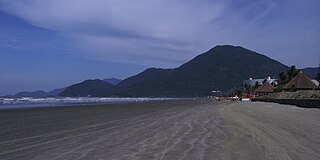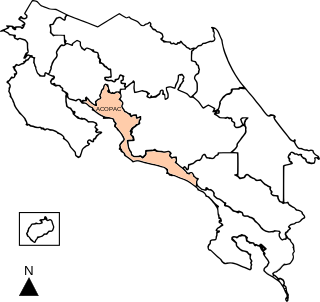
A nature reserve is a protected area of importance for flora, fauna, or features of geological or other special interest, which is reserved and managed for purposes of conservation and to provide special opportunities for study or research. They may be designated by government institutions in some countries, or by private landowners, such as charities and research institutions. Nature reserves fall into different IUCN categories depending on the level of protection afforded by local laws. Normally it is more strictly protected than a nature park. Various jurisdictions may use other terminology, such as ecological protection area or private protected area in legislation and in official titles of the reserves.

Peruíbe is a municipality in the state of São Paulo in Brazil. It is part of the Metropolitan Region of Baixada Santista. The population is 69,001 in an area of 324.55 square kilometres (125.31 sq mi). Peruíbe is located to the southwest of the city of São Paulo and west of Santos.

Protected areas of Brazil included various classes of area according to the National System of Conservation Units (SNUC), a formal, unified system for federal, state and municipal parks created in 2000.

The great green macaw, also known as Buffon's macaw or the great military macaw, is a Central and South American parrot found in Nicaragua, Honduras, Costa Rica, Panama, Colombia and Ecuador. Two allopatric subspecies are recognized; the nominate subspecies, Ara ambiguus ssp. ambiguus, occurs from Honduras to Colombia, while Ara ambiguus ssp. guayaquilensis appears to be endemic to remnants of dry forests on the southern Pacific coast of Ecuador. The nominate subspecies lives in the canopy of wet tropical forests and in Costa Rica is usually associated with the almendro tree, Dipteryx oleifera.

Central Pacific Conservation Area is an administrative area which is managed by SINAC for the purposes of conservation in the southwestern part of Costa Rica, on the Pacific coast. It contains four National Parks, and a number Wildlife refuges and other types of nature reserve.

The protected areas of Nicaragua are areas that have natural beauty or significance and are protected by Nicaragua. Nicaragua has 78 protected areas that cover 22,422 km², about 17.3% of the nations landmass. The National System of Protected Areas (SINAP) is administered by the Ministry of the Environment and Natural Resources (MARENA).
The Congal Biomarine Station is a protected nature reserve created in 2000 and is located in southwestern Esmeraldas Province, close to the town of Muisne in northwestern Ecuador. The Congal Reserve is managed by the Jatun Sacha Foundation and features beach, estuarine, mangrove, wetlands and humid tropical forest habitats, accounting for the region's high biodiversity and local endemism. The station was founded by the Quiroga family in partnership with conservationist, Arlo Hemphill.
Rio Trombetas Biological Reserve is a federally-administered biological reserve in the municipality of Oriximiná, Pará, Brazil. It covers a large area of Amazon biome including rainforest, wetlands and water.

Oriximiná is the westernmost and second-largest municipality in the Brazilian state of Pará. It is also the fourth-largest in the country.
Under UNESCO’s Man and the Biosphere Programme, there are 125 biosphere reserves recognized as part of the World Network of Biosphere Reserves in Latin America and the Caribbean. These are distributed across 21 countries in the region.

Una is a city in Bahia, Brazil. Its population in 2020 was 18,544 inhabitants. It is located about 36 mi (58 km) south from Ilheus.

Yacurí National Park is a 431-square-kilometre (166 sq mi) National Park in Ecuador located on the border between the provinces Loja and Zamora Chinchipe. It is part of a larger Protected Forest of 733 km2 (283 sq mi). It was founded in 2009. The headwaters for both the Chinchipe-Mayo (east) and Catamayo-Chira (west) water basins are in the park.
Protected areas of Panama include:

Cuniã Ecological Station is a strictly protected ecological station in the states of Amazonas and Rondônia, Brazil. It preserves an area of savannah parkland on the border of the Amazon rainforest. The conservation unit is rich in lakes and ponds, and serves as a nursery for various species of fish.

The Southern Amazon Mosaic is a protected area mosaic in Brazil.

The Una Wildlife Refuge is a wildlife refuge in the state of Bahia, Brazil.

The Rio dos Frades Wildlife Refuge is a wildlife refuge in the state of Bahia, Brazil. It protects the land around the mouth of the Frades River. There is pressure, or opportunity, to develop the reserve for tourism.

The Mache River is a river that enters the Pacific Ocean through the Cojimies Estuary on the north coast of Ecuador.

The protected areas of Puerto Rico include an array of natural areas in the archipelago of Puerto Rico, an unincorporated territory of the United States, managed by a number of agencies and entities belonging to both federal and commonwealth government bodies. Although Puerto Rico has no natural units in the National Park System, the biodiversity of the island is recognized and protected through a national forest, a national wildlife refuge, a national wilderness, and numerous state parks, nature reserves, state forests, wildlife preserves and other designations on state, municipal and public-private administration levels.























